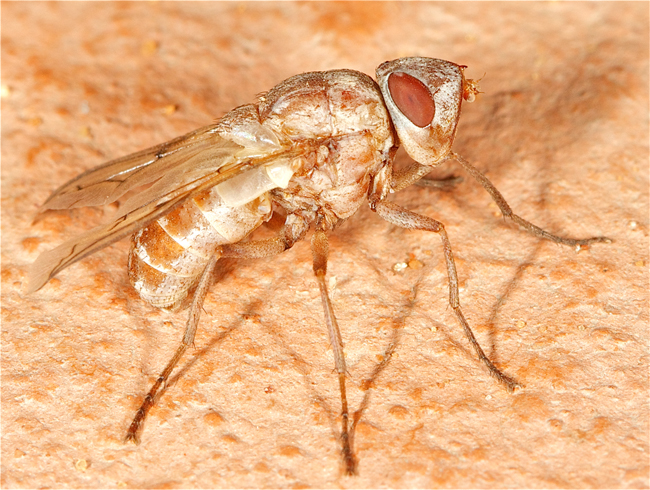Family: Calliphoridae
Female, Marloth Park
Description
Stout, yellow-brown, 8-12 mm in length. Face and legs yellow. Two black marks on the thorax. Adult flies feed on decaying fruits, carrion and faeces and have large, fully developed mouthparts. The arista of the antenna has setae on both sides. The thoracic squamae are without setae and the stem vein of the wing is without bristles.
It is a parasite of large mammals (including humans) during its larval stage and is a common cause of myiasis in humans in some regions.
The fly lays the eggs in soil, clothing or bedding. When an animal lays down on the affected area, the body heat attracts the hatched larvae and it then burrows into the skin. There they live off the bodily fluids of the host until they are ready to pupate. This fly species generally parasitises large mammals including dogs and, inadvertently, humans. The flies typically deposit their eggs in soil but will also lay them on soiled clothing.
Humans can become infected by these larvae by donning clothes on which eggs have been laid. It is extremely important to note that washing should not be laid on the ground to dry. The NIDC said treatment consisted of covering the lesion with Vaseline or liquid paraffin, which suffocates the larva. Treatment should be left on for 30 minutes to an hour and then the larva should be pushed out via finger pressure.
It said attempted removal by instruments may rupture the larva and cause severe inflammation. It is advisable to seek medical attention for you or your animal should you suspect an infestation, to prevent any further inflammation or discomfort.
Distribution
This fly has been endemic in the subtropics of Africa for more than 135 years. According to the National Institute for Disease Control (NIDC), this fly is common in Africa and occurs in the northern regions of South Africa including Northern Cape, Gauteng, KwaZulu-Natal, Limpopo, Mpumalanga and North West provinces.




